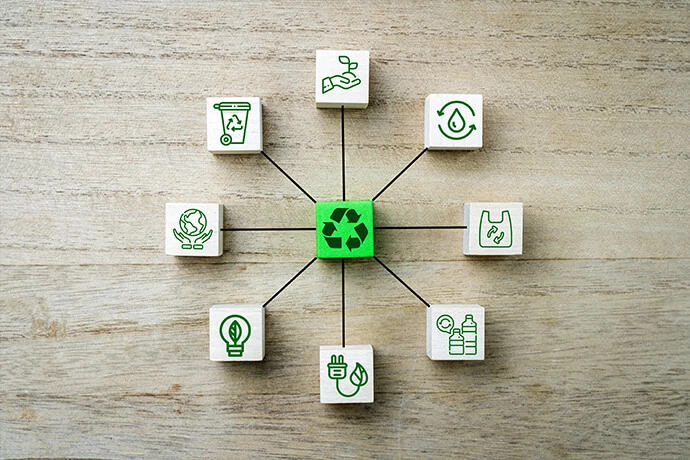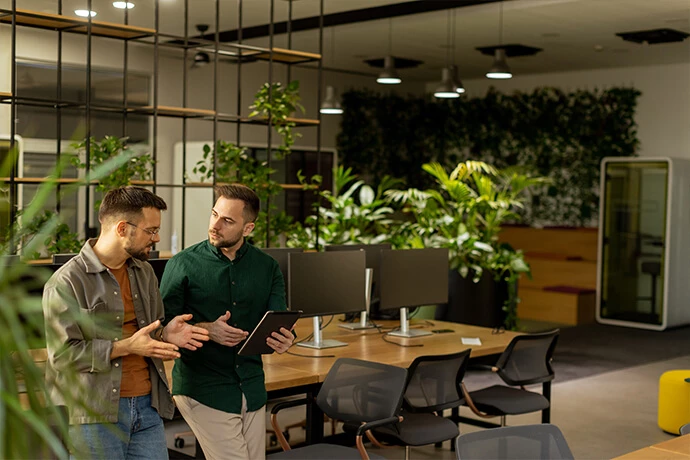 SPEAKERS
SPEAKERS
 TOPICS
TOPICS
Employee happiness and engagement are pivotal for organizational success. Prioritize a people-first approach to build a sustainable workforce, ensuring long-term prosperity.

How happy and engaged are your employees? Adopting a people-first strategy in your organizational structure is no longer another fancy approach. It shouldn’t be an afterthought but a priority since a sustainable workforce is the key to long-term success.
But what is workforce sustainability?
A sustainable workforce focuses on the fact that every employee is offered equal opportunities and fair wages in a safe and innovative work environment that accounts for their well-being. Such a structure makes it easier to keep employees motivated and highly productive in the long run.
So, how can you build such a sustainable workforce?
Read on for practical strategies to help you develop and maintain a sustainable workforce.
Do employees see a future for themselves in your organization? Does the workforce reflect the diversity of the community around the organization? What is sustainable employment?
Ask many employees that question, and the answer at the top of most of their minds will revolve around what the future holds for them and how inclusive the workforce feels. If your organization doesn’t offer career development opportunities, the employee retention rate will consistently drop. That’s because employees don’t feel that there’s a future for them and will look for employers offering career paths for advancements. Measures such as mentorship programs help provide clear career advancement paths that’ll keep employees engaged with your organization.
Besides career growth opportunities, the organization must also build a workforce that reflects diversity. A “DEI” (diversity, equity, and inclusion) strategy is recommended. Diversity fosters new perspectives, while equity ensures the organization creates fair and equal opportunities for every employee. Inclusion creates a sense of belonging.
DEI strategy makes it easier to build a sustainable workforce. That’s because your organization will easily attract the best talent and, with fair treatment and opportunities, retain them. The workforce will be more innovative as they embrace and pursue diverse perspectives. They will also remain engaged and motivated to work together as inclusion measures create a sense of belonging.

Workforce burnout has been a challenge for a long time. Physical and emotional exhaustion means that employees can hardly maintain desirable productivity levels. Organizations suffer from this exhaustion as cases of absenteeism and job dissatisfaction rise. This leads to a steady rise in employee turnover rate, a costly aspect every company strives to address. Even the retained employees aren’t as productive since the burnout leads to psychological and physical concerns affecting motivation and productivity.
Prioritizing work-life balance has recently been the main highlight of sustainable workforce meaning. Strategies designed to facilitate flexible work arrangements, including remote and hybrid work options, have significantly redefined how organizations manage work schedules. The strategies create a better balance between work and personal life, which helps reduce workplace burnout rates.
Employee wellbeing can’t take the backseat either. Employers must develop a supportive work environment to build and maintain a sustainable workforce. This isn’t simply ensuring the employees have the right gear and safe work settings. Employee wellbeing extends to their psychological safety. This is why more organizations continue to adopt programs that promote mental and physical well-being. They collaborate with teamwork speakers not simply to motivate but also to address psychological aspects in the workplace.
Effective stress management and ergonomic assessments, among other employee wellbeing programs, significantly boost their mental and physical wellness, fostering long-term workforce sustainability.
Employee development is among the terms you’ll repeatedly encounter in HR practices. Employee development strategies have stood the test of time, proving to be among the most effective long-term employee engagement measures.
Here are two sustainable employment examples regarding employee development:

You know your employees by name or department, but do you understand them? Regular employee surveys may seem unnecessary, but they can help you uncover a lot. The process is more straightforward in the modern age as you can integrate technology features like employee satisfaction surveys into HR software. This makes it easier to track employee sentiment, understand their satisfaction rate, and spot areas for improvement. Leveraging such data-driven measures to understand and manage your workforce delivers many benefits. You’ll effectively analyze skills gaps and bridge them through upskilling or skilling. You’ll also identify high-potential employees and facilitate their development and transition to leadership through mentorship programs. You’ll also make informed decisions about training and development programs that foster equality and inclusivity across the board.
Do your employees live in dignity? If the wages are so low that they can’t provide for the employee and their families, they’d have to work extra shifts or take additional jobs. This significantly impacts their productivity. Besides the exhaustion, they can’t feel appreciated.
Therefore, they would quickly leave if they found better opportunities. Such an employee turnover rate can significantly impact your efforts to build a sustainable workforce, emphasizing the need for fair wages. In addition to fair wages, you should also embrace social justice. This includes adequate worker representation, empowering the employees with the right technology tools, and approaching automation responsibly.
Such a strategy means employees will easily air their concerns, meet if not exceed expectations since they’re well-equipped, and won’t be anxious about being replaced. This creates a safe environment and allows the employees to focus on their core functions. Fair wages and social justice empower employees and keep them engaged and motivated, allowing organizations to build a sustainable workforce.
Implementing the above strategies may seem costly and overwhelming. But the reward is worth the investment, if not more. You’ll build a sustainable workforce, this means the employees will be happy, satisfied, and productive. This helps future-proof your organization and makes a sustainable workforce a worthy investment that pays long-term rewards.
As you strive to keep up with emerging trends for sustainable growth, you shouldn't ignore your workforce. It’s the force that drives your organization forward, and without it, you can hardly survive, not to mention thrive.